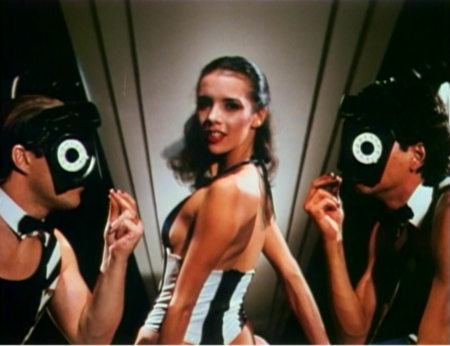
Mitchell Froom’s soundtrack for the pornographic cult classic Café Flesh (1982) is finally getting the widespread attention it deserves. Although Froom released much of the music he recorded for the film on his album Key of Cool, a proper soundtrack had only been available previously as a bootleg. The Fun City Editions release of the Café Flesh soundtrack is simple in its design but sports top notch materials and printing on the package that help make this release as essential to any self-respecting cinephile as their home video releases.
The film Café Flesh is notable for the participation of Stephen Sayadian and Jerry Stahl. Beyond the merits and various points of interest regarding the film itself, Froom’s musical contributions were essential to the development of synthesizer compositions in the early eighties that would eventually lead to the instrument becoming the trademark sound of the decade. What Froom does is employ the synthesizer throughout a series of jazz inspired compositions that evoke the film noir pictures of the late fifties as well as Weimar era nightclub music. Essentially Froom did for jazz what Brian Eno and Silver Apples did for pop-rock.
Aesthetically Froom’s take on jazz is not dissimilar to that of the contemporaneous Lounge Lizards (lead by John Lurie). The brevity of punk rock seems to have influenced Froom’s condensed, albeit still complex, sonic ruminations. So while the arrangement recalls musical forms of the past, the style of the compositions is very much rooted in the present of 1982. Interestingly, throughout the eighties the synth was often still employed to signify the future just as it had been in the previous two decades.
Froom was obviously motivated to incorporate jazz sounds of the twenties and thirties by the look of the film Café Flesh itself. The production design on the picture utilizes many art deco influences that create a series of highly performative yet abstract spaces akin to Busby Berkley musicals. In juxtaposition to these designs the cinematography and direction is very much rooted in the moment of the production. Cinematographically the visual strategies in Café Flesh are in reaction to MTV music videos. Again, past meets present in a work pre-occupied with the future.
The track “Thrill Factor”, clocking in at under two minutes, is an excellent example of Froom’s work on Café Flesh. There is something distinctly Duke Ellington-esque about the piece even though it incorporates elements common in the music of Stewart Copeland and the band Wall Of Voodoo. “Thrill Factor” exemplifies the calculated timelessness of Froom’s work on Café Flesh. This quality creates an immediacy in the music which is as impactful now as it was more than forty years ago.
